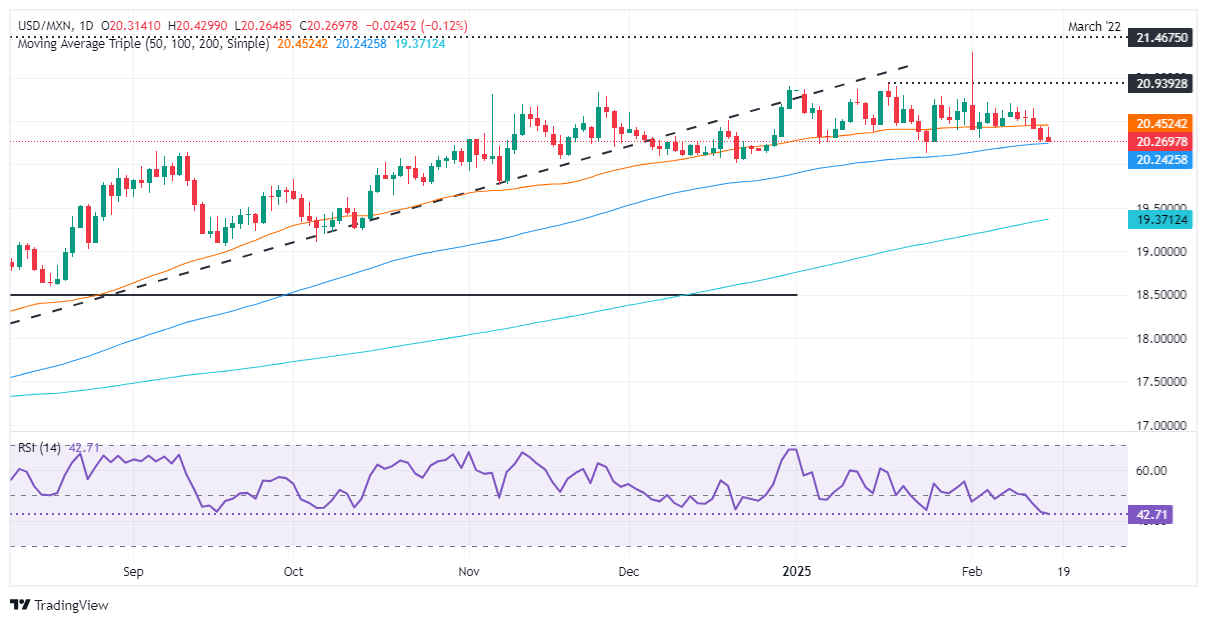Mexican Peso extends rally to six days amid lack of catalyst
- USD/MXN dips below 50-day SMA at 20.42, trading at 20.27.
- Weak US Retail Sales and softer PPI sub-components fuel Fed easing expectations.
- Mexico’s Retail Sales, Banxico minutes, and Q4 GDP are in focus this week.
The Mexican Peso (MXN) extended its gains versus the US Dollar (USD), clearing key support at the 50-day Simple Moving Average (SMA) of 20.42 as the USD/MXN found acceptance at lower exchange rates. At the time of writing, the exotic pair trades at 20.27, down 0.09%.
Last week’s worse-than-expected United States (US) Retail Sales report drove the USD/MXN pair lower amid the uncertainty about economic growth in the US.
Although US consumer inflation data surged, some sub-components of the Producer Price Index (PPI) used to calculate the Federal Reserve’s (Fed) preferred inflation gauge, the Core Personal Consumption Expenditures (PCE) Price Index, suggests that prices could aim lower, increasing the chances for Fed’s easing.
After Friday’s data, figures from the Chicago Board of Trade (CBOT) suggest that investors had priced in 43 basis points (bps) of easing.
Despite this, the Philadelphia Fed President Patrick Harker stated that the current state of the economy justifies maintaining a steady rate policy, noting that monetary policy is well-positioned now. He acknowledged that inflation has remained elevated and persistent in recent months, emphasizing that the Fed's policy stance should continue to work towards lowering inflation.
Ahead of this week, Mexico’s economic docket will feature Retail Sales for December, the release of Banco de Mexico (Banxico) latest meeting minutes, and Gross Domestic Product (GDP) figures for Q4 2024.
Daily digest market movers: Mexican Peso climbs despite Banxico’s dovish stance
- Monetary policy divergence between Banxico and the Fed favors further USD/MXN upside, as the Fed would likely hold rates for a longer period, while Banxico is expected to cut rates again by 50 basis points in the next meeting.
- The US Dollar Index (DXY), which tracks the buck's performance against a basket of currencies, is virtually unchanged at 106.77, a headwind for USD/MXN.
- Trade disputes between the US and Mexico remain in the boiler room. Although the countries found common ground previously, USD/MXN traders should know that there is a 30-day pause and that tensions could arise toward the end of February.
USD/MXN technical outlook: Mexican Peso surges as USD/MXN drops below 50-day SMA
USD/MXN trends lower on Monday and close into the 100-day SMA at 20.24, which, if cleared, could open the door for further downside. The Relative Strength Index (RSI) turned bearish, which indicated that the exotic pair could be headed to the 20.00 psychological figure.
In that outcome, if sellers push prices below 20.00, the next support would be the October 18 swing low at 19.64, followed by the 200-day SMA at 19.37.
Conversely, if USD/MXN rises back above the 50-day SMA, the next resistance would be 20.50, followed by the January 17 high of 20.90, the 21.00 figure, and the year-to-date (YTD) high of 21.29.
Risk sentiment FAQs
In the world of financial jargon the two widely used terms “risk-on” and “risk off'' refer to the level of risk that investors are willing to stomach during the period referenced. In a “risk-on” market, investors are optimistic about the future and more willing to buy risky assets. In a “risk-off” market investors start to ‘play it safe’ because they are worried about the future, and therefore buy less risky assets that are more certain of bringing a return, even if it is relatively modest.
Typically, during periods of “risk-on”, stock markets will rise, most commodities – except Gold – will also gain in value, since they benefit from a positive growth outlook. The currencies of nations that are heavy commodity exporters strengthen because of increased demand, and Cryptocurrencies rise. In a “risk-off” market, Bonds go up – especially major government Bonds – Gold shines, and safe-haven currencies such as the Japanese Yen, Swiss Franc and US Dollar all benefit.
The Australian Dollar (AUD), the Canadian Dollar (CAD), the New Zealand Dollar (NZD) and minor FX like the Ruble (RUB) and the South African Rand (ZAR), all tend to rise in markets that are “risk-on”. This is because the economies of these currencies are heavily reliant on commodity exports for growth, and commodities tend to rise in price during risk-on periods. This is because investors foresee greater demand for raw materials in the future due to heightened economic activity.
The major currencies that tend to rise during periods of “risk-off” are the US Dollar (USD), the Japanese Yen (JPY) and the Swiss Franc (CHF). The US Dollar, because it is the world’s reserve currency, and because in times of crisis investors buy US government debt, which is seen as safe because the largest economy in the world is unlikely to default. The Yen, from increased demand for Japanese government bonds, because a high proportion are held by domestic investors who are unlikely to dump them – even in a crisis. The Swiss Franc, because strict Swiss banking laws offer investors enhanced capital protection.




